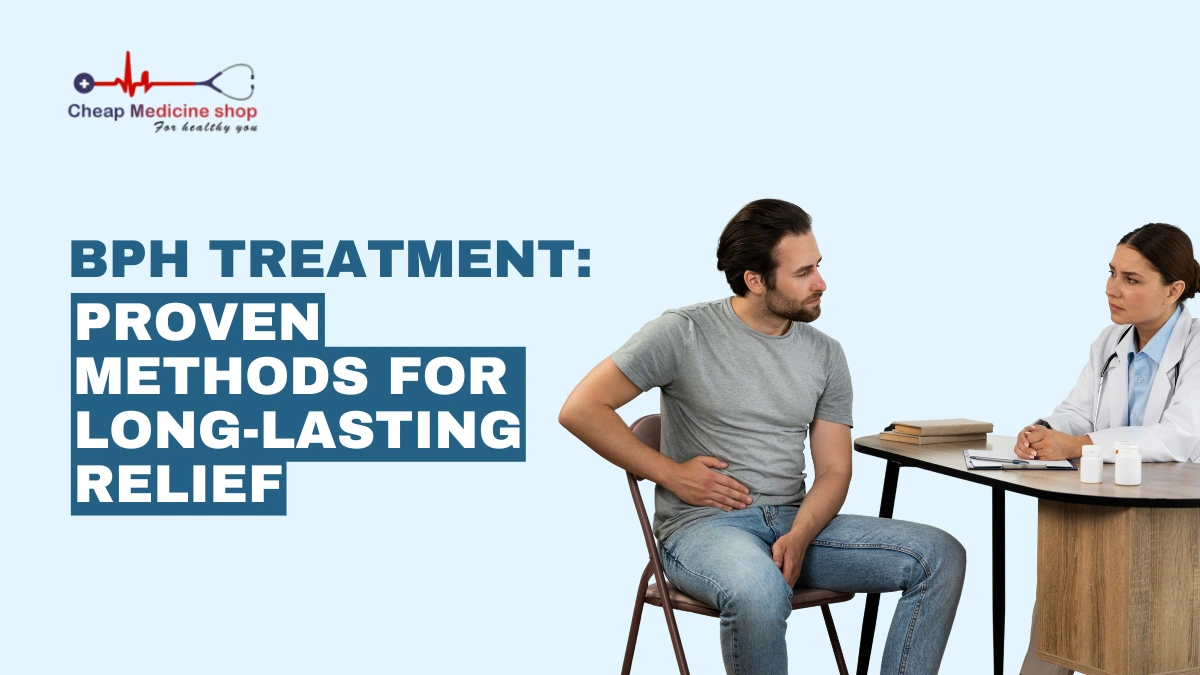Benign Prostatic Hyperplasia (BPH), commonly called an enlarged prostate, is an uncomfortable condition that affects 80% of 70-year-old men in the US. This condition leads to urinary issues, such as a weak stream or incomplete emptying, which can disrupt personal routines, sleep, and work.
The good news is that proven treatment methods can provide significant improvement. These include medicines that can relax the prostate, minimally invasive procedures to remove blockage, and surgeries for chronic cases. Apart from these, some lifestyle changes can help control symptoms and stop the condition from getting worse.
In this article, we will cover these effective BPH treatment options and safety tips to keep in mind. With proper treatment knowledge, you’ll be able to choose the right approach for lasting relief.
Effective BPH treatments
Untreated BPH can lead to bladder stones and other severe complications. Fortunately, a wide range of effective treatments is available. From medications or surgical procedures, they can improve quality of life by reducing symptoms.
Understanding these methods will help maintain normal urinary function. Given below are medical approaches to deal with the condition:
Save up to 90% on your medicine bills

Uripro 0.4 Capsule PR

Veltam Plus 0.4 mg
Contiflo Icon 0.4 mg Tablet PR

Urisurge Tablet PR
Medications for BPH
A doctor typically begins treatment for BPH with medications before considering other procedures if symptoms worsen or persist. Medications will help to improve urine flow and relieve discomfort. Listed below are the available options:
- Alpha-blockers: They work by relaxing the prostate muscles and the neck of the bladder, making urination easier. They function quickly, generally relieving symptoms within days or weeks.
- 5-Alpha-Reductase Inhibitors (5-ARIs): These medicines reduce prostate size by blocking the 5-alpha-reductase enzyme. It reduces the risk of urinary retention (inability to empty the bladder) and progression of BPH. They are effective for larger prostates.
- Combination therapy: This method uses both medication classes to offer long-term size reduction and rapid relief. Medicine like Urimax D Tablet MR, containing Alpha-blockers, is often prescribed to men with severe symptoms.
Minimally invasive procedures for BPH
Doctors usually recommend minimally invasive procedures when medications cause serious side effects or prove ineffective. Such procedures have short recovery durations and a low risk profile in comparison to major surgery. The commonly suggested procedures are:
- Prostatic urethral lift (UroLift): Small implants are inserted in enlarged prostate tissue to lift and hold it away from the urethra. This is done to improve urine flow without heating/cutting tissue. It is safe, although it may cause temporary side effects.
- Water vapor thermal therapy (Rezum): The Rezum procedure uses sterile steam to shrink prostate cells, destroying excess tissue. Steam is injected through the urethra, effectively treating BPH symptoms.
- Laser therapies: Commonly include the GreenLight Laser, which vaporizes excess tissue, and Holmium Laser Enucleation of the Prostate (HoLEP), which cuts and removes tissue. HoLEP is typically used for larger prostates. These therapies enable the free flow of urine almost immediately.
- Others: Transurethral Needle Ablation (TUNA), which is radiofrequency-based, and Transurethral Microwave Therapy (TUMT) are less frequently used. These procedures involve insertion of an antenna into the urethra. Antennae generate heat through microwaves or radiowaves, destroying excess tissue.
Surgical procedures for BPH
Surgical procedures are considered when medications and lifestyle changes offer no improvement. The following procedures represent key treatment options:
- Transurethral Resection of the Prostate (TURP): TURP is considered the gold standard procedure for treating BPH. It involves prostate tissue removal that blocks the urethra. It provides effective relief from Lower Urinary Tract Symptoms (LUTS).
- Open or Robotic Prostatectomy: It includes the surgical removal of the prostate tissue. The open method involves a single large cut in the lower abdomen with a 4-6 week recovery period. The robotic approach involves a small cut made by robotic arms, with a recovery duration of 1-2 weeks.
Lifestyle adjustments for BPH
Simple lifestyle changes can complement the surgical or medicinal treatment, especially in cases of mild symptoms. They also help manage daily life.
- Exercise: Regular physical activity helps control weight, easing pressure on the bladder. Kegel exercises strengthen pelvic muscles and improve urinary flow. Even daily walks can be beneficial in promoting overall prostate health.
- Fluid management: Limiting alcohol and caffeine can reduce urine urgency and irritation. Reducing fluid intake in the evening also helps decrease the frequency of nighttime bathroom trips. Proper hydration is still essential.
- Dietary choices: Eating more whole grains, fruits, and vegetables supports prostate and urinary health. A study published by Nutrients in 2021 reported that men with daily red meat consumption have a 38% increased risk of BPH, whereas men having 4 or more servings of vegetables have a 32% lower BPH risk.
- Timed voiding: It is also called bladder training and involves urination at scheduled times. Timed voiding will reduce the frequency by gradually training the bladder to control urine for longer periods.
Safety and precautions
BPH treatments are usually safe, but one should be cautious of limitations and potential risks. Regular medical monitoring can lead to better treatment outcomes. A few points to keep in mind are:
- Medication side effects: Alpha-blockers and 5-ARIs can cause some side effects, including dizziness and low libido, respectively. Dose adjustments can help manage these unwanted effects.
- Regular supervision: Follow-up visits with a urologist (a urinary system specialist) help monitor improvements in prostate size and urinary flow. It also helps identify Prostate Cancer, which has signs similar to BPH.
- Medical guidance: Never start or discontinue treatment without a doctor’s consultation. A treatment is selected based on the severity of the condition, prostate size, and overall health.
- Procedure risks: Surgical methods, like TURP, can cause Retrograde Ejaculation or bleeding issues. While these issues are usually temporary after surgery, a doctor’s consultation is advised.
Conclusion
BPH affects many men but is manageable with the right approach. BPH treatment offers several methods, from medications and surgical techniques to lifestyle changes.
Minimally invasive procedures, like UroLift and laser therapies, provide quick relief with less recovery time, while surgery, like TURP, is beneficial in severe cases. Early intervention can prevent potential complications and alleviate symptoms.
Getting to know risks and safety measures helps make informed decisions. Regular medical monitoring is crucial for maintaining quality of life and controlling BPH symptoms. Ultimately, selecting the proper treatment will depend on your overall health, prostate size, and severity of symptoms.

Frequently Asked Questions
What is the best position to pee with an enlarged prostate?
The best position to pee with an enlarged prostate is sitting down instead of standing. Several studies have reported that the sitting position decreases the amount of urine remaining in the bladder after urination, known as post-void residual volume. It also helps shorten the time needed to urinate and increase flow.
What happens if an enlarged prostate goes untreated?
If an enlarged prostate goes untreated, it can elevate the risk of bladder stones and Urinary Tract Infections (UTI). This is because untreated BPH causes urinary retention. Moreover, it can thicken the bladder muscle, creating difficulty in urinating. This will create pressure on the kidneys, leading to kidney damage or even kidney failure.
What is the longest-lasting treatment for BPH?
Aquablation therapy is one of the longest-lasting treatments for BPH, involving the use of a water jet (robot-controlled) for the precise removal of excess prostate tissue. Other treatments with long-term relief include TURP, Rezum (water vapor therapy), and UroLift.
Does ejaculating help an enlarged prostate?
No, ejaculating can not help an enlarged prostate condition. It can’t reverse the condition or shrink the size. Although ejaculation is linked with overall prostate health, it can’t relieve BPH symptoms. Consult a doctor if you have an enlarged prostate.
Cheap Medicine Shop only refers to credible, authoritative sources for our content. If you’re curious about how we ensure the integrity of our content, we encourage you to read our Content Information Policy.














